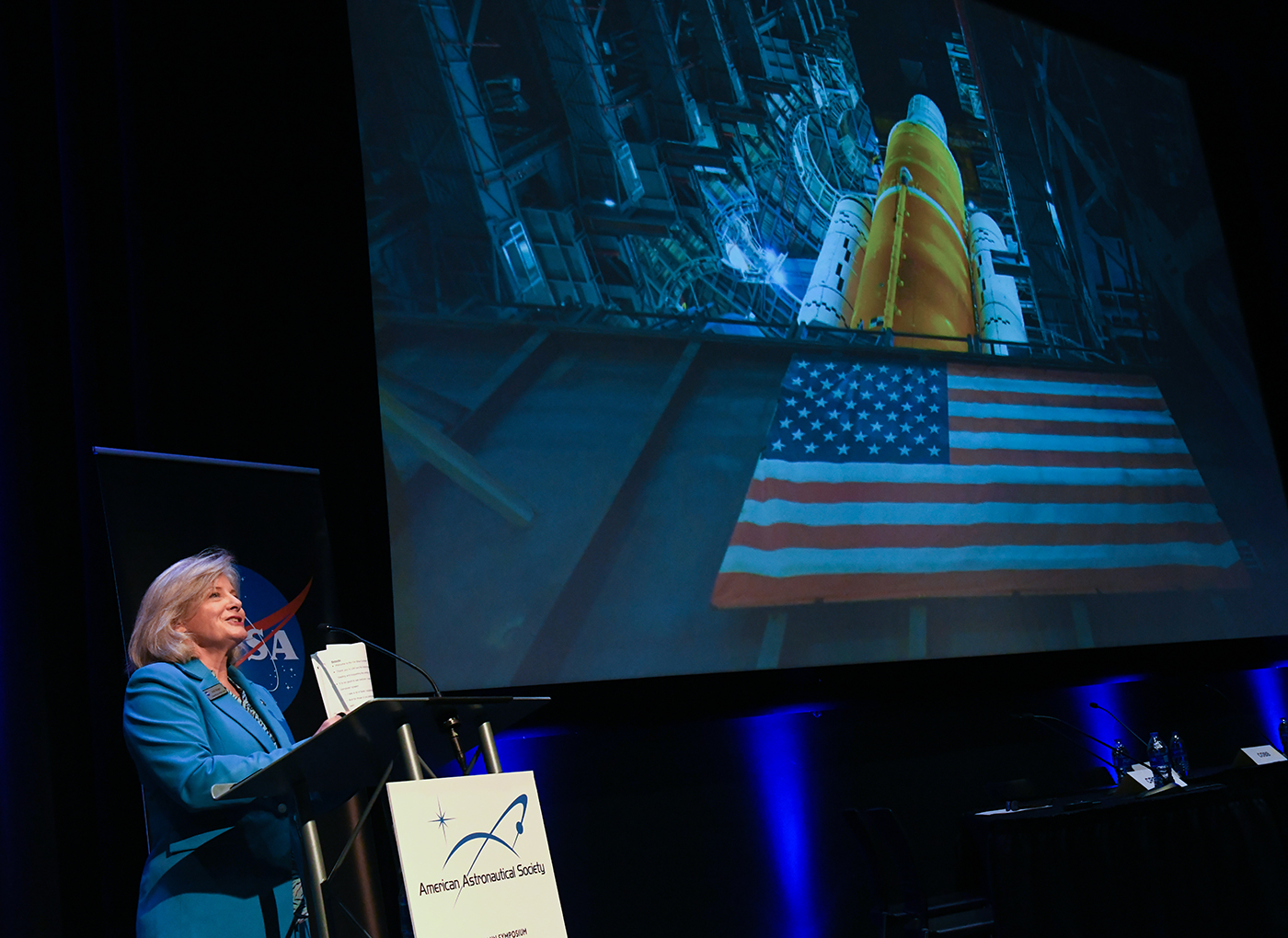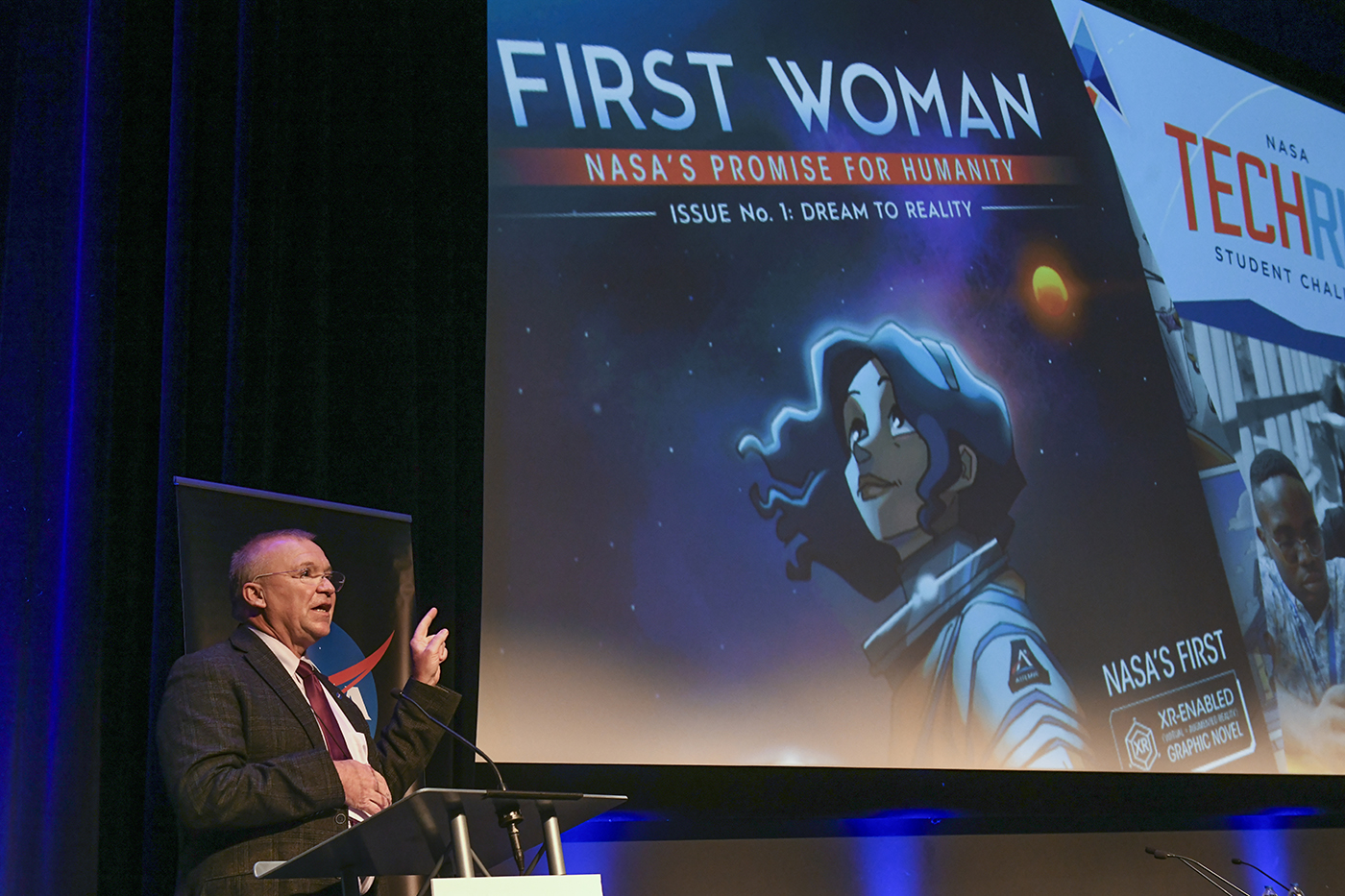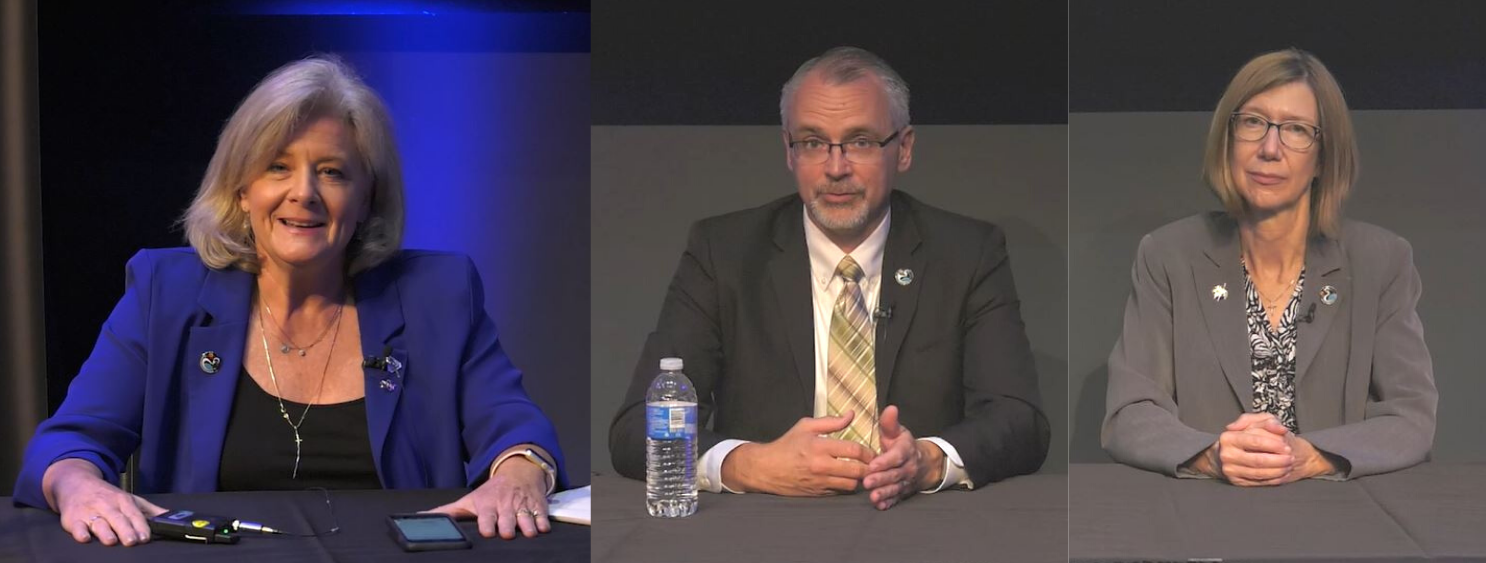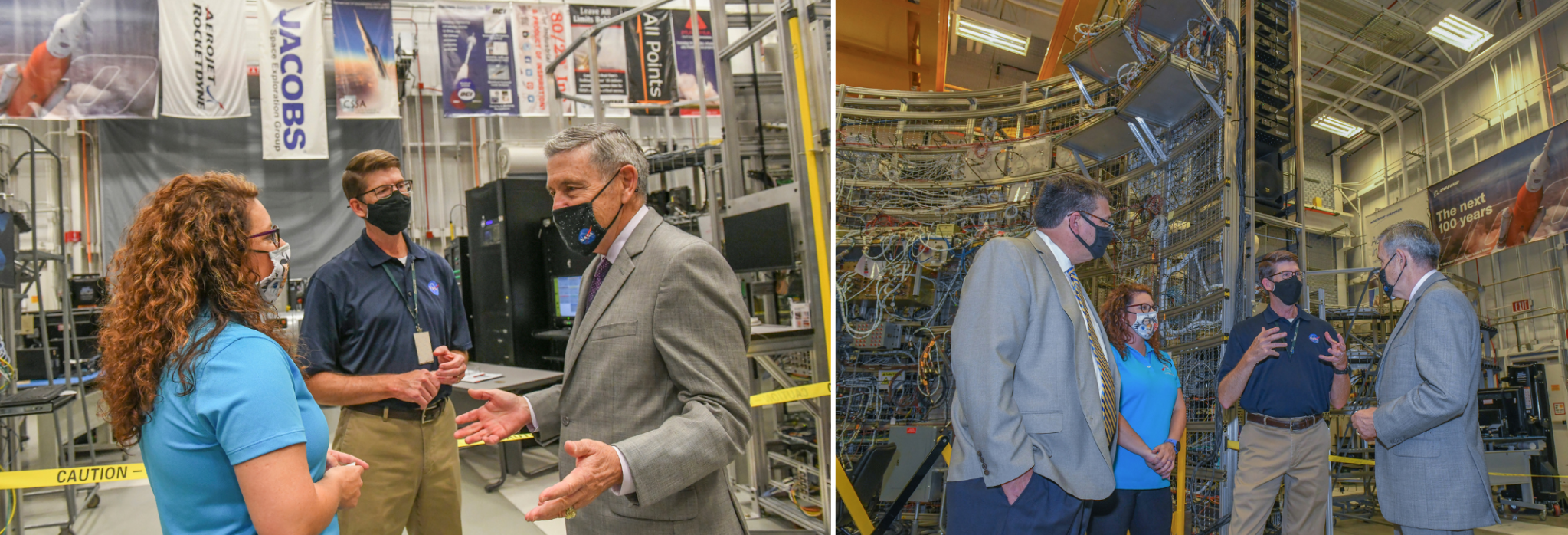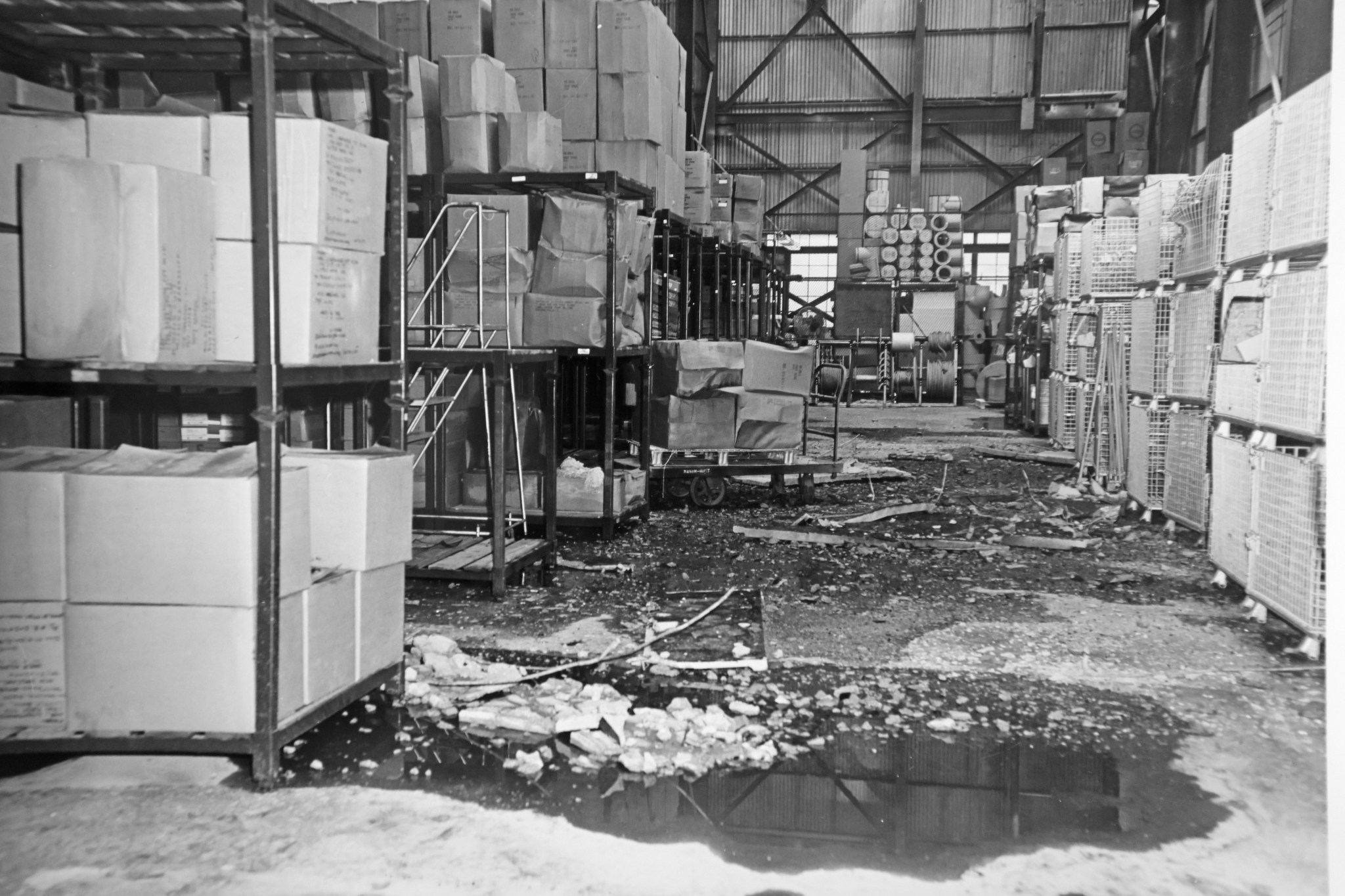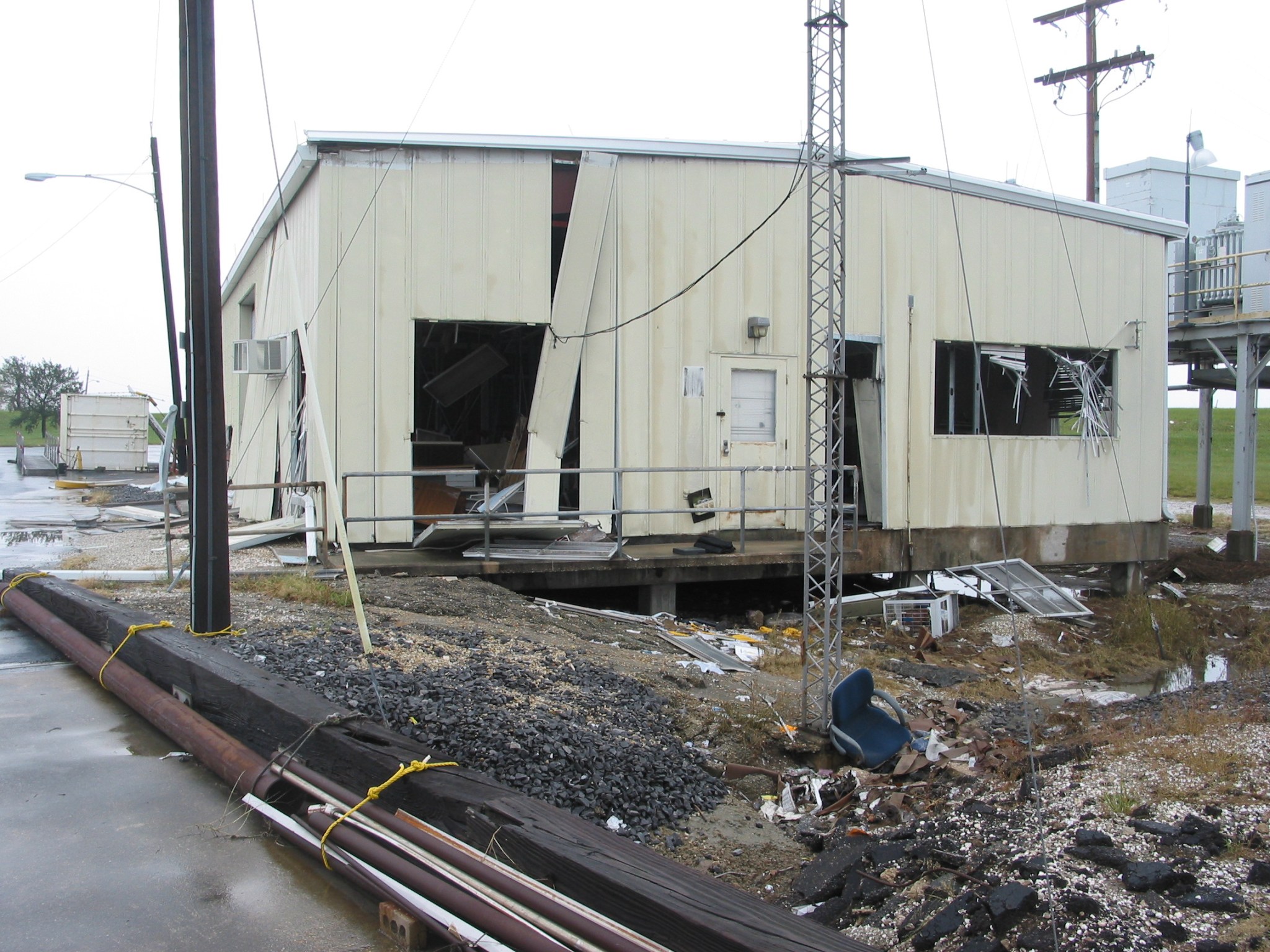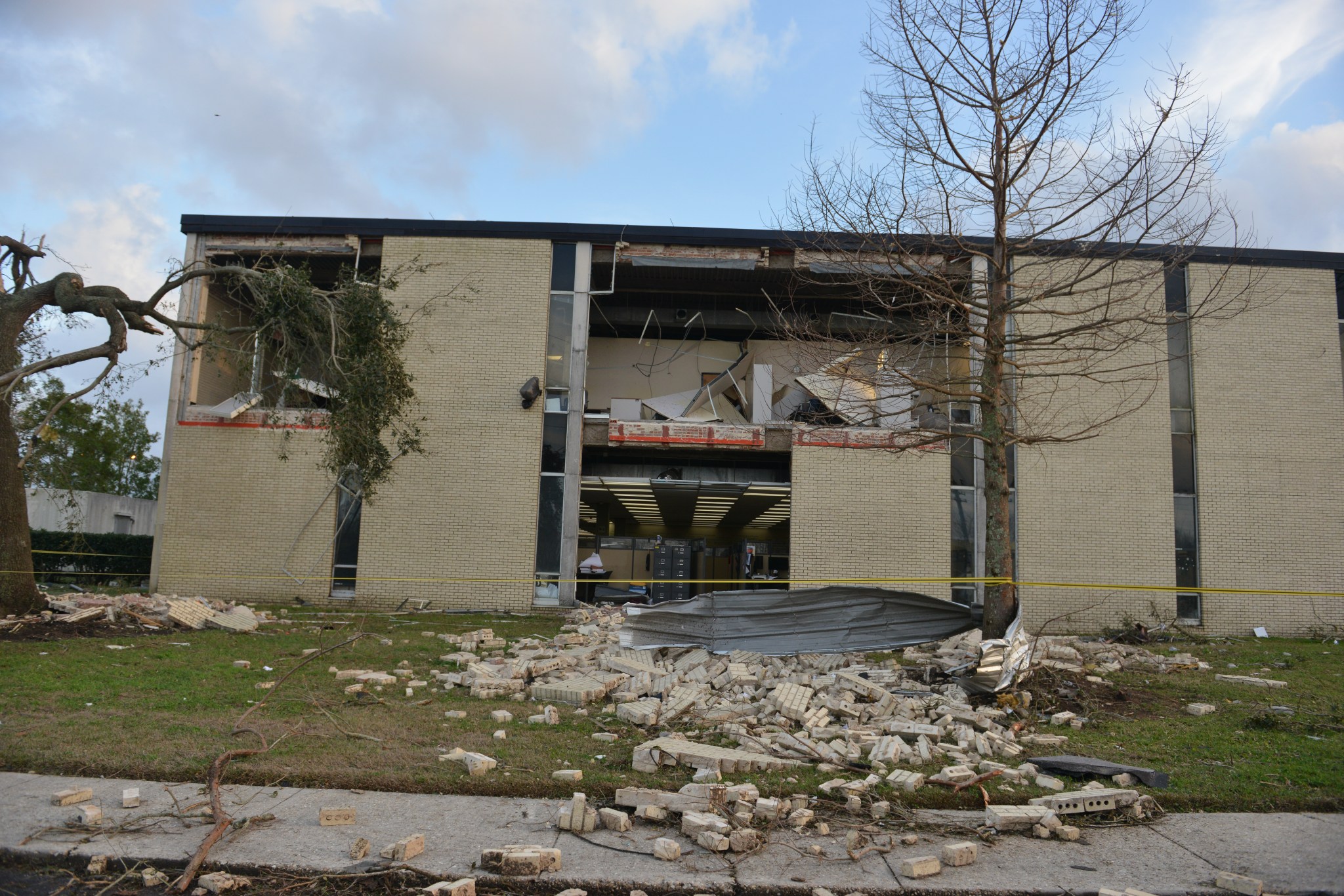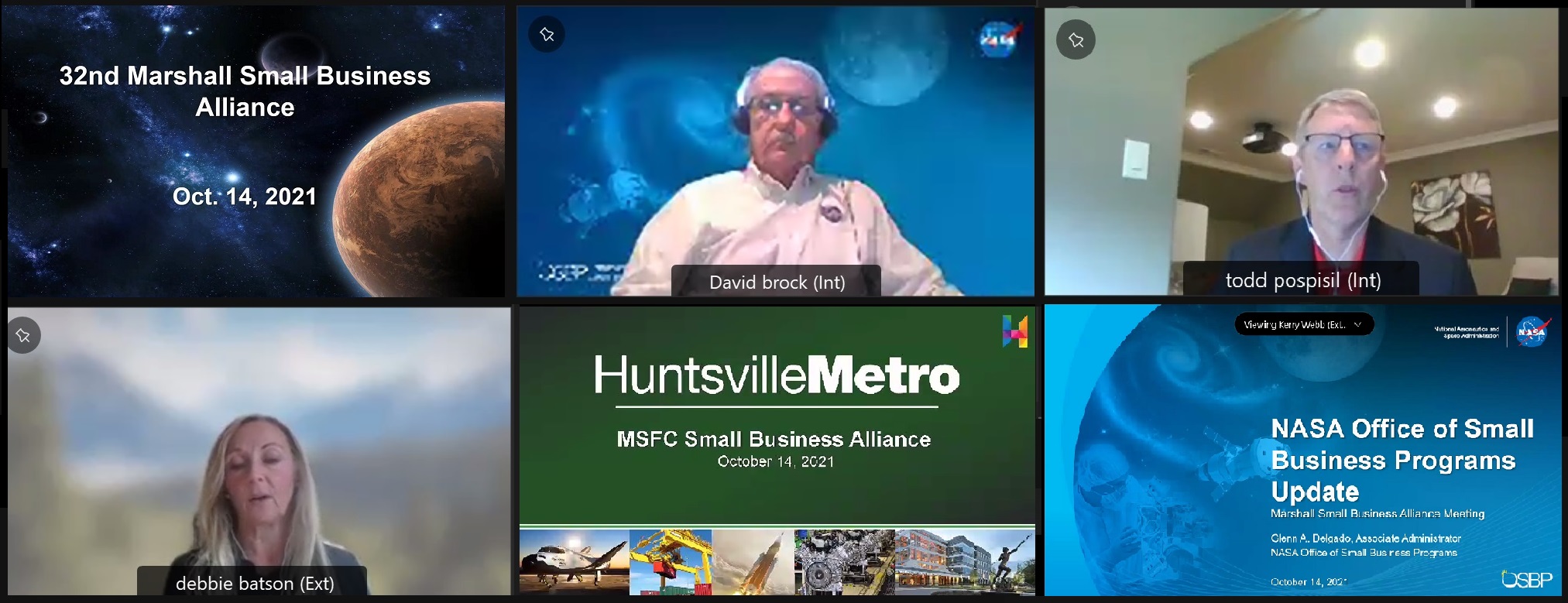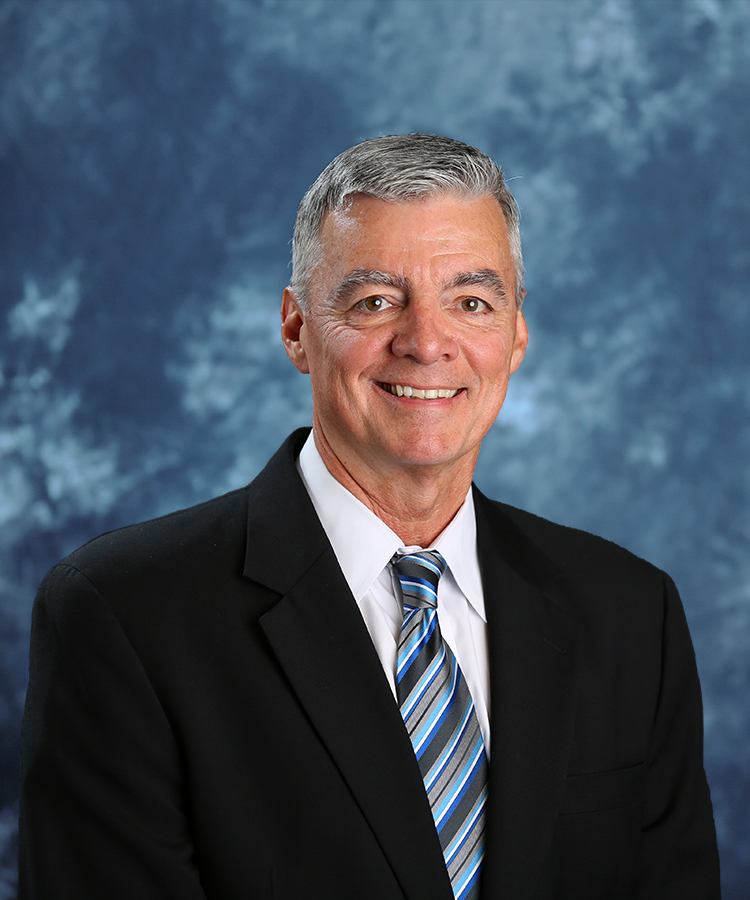NASA Leaders Laud Unity, Teamwork at Von Braun Symposium
By Wayne Smith
From deep space exploration to continuing to push forward through the pandemic, NASA executives and other industry experts discussed a wide range of topics at the Wernher von Braun Memorial Symposium.
An ongoing team effort was the central message of the 14th annual event, which concluded Oct. 14 at the University of Alabama in Huntsville. The symposium returned to an in-person format and was also available virtually. The American Astronautical Society hosted the three-day conference.
“It has been such a trying time, but I’m so very proud of our Marshall Space Flight Center team for delivering on our mission despite all the obstacles – from storms, hurricanes, and tornadoes, to COVID and everything,” Marshall Director Jody Singer said. “I just am amazed every day at the dedication of our folks. It’s just not the civil servants at Marshall, but it’s everybody in this community working together to make it happen.”
The theme for the symposium was, “United: A Foundation Delivered, the Future Enabled.” Singer said the title was appropriate as NASA embarks on the next generation of deep space exploration through the Artemis program and the Space Launch System.
“To me, that is such a true thing, thinking about laying our foundation for the future, whether it be in education or business,” Singer said. “What we’re doing to pay it forward really does make a difference in enabling our future and to what we’re now working on at NASA and what we’re working on together.
Singer said in building on NASA’s legacy, new chapters are being written through the combination of the agency and its industry partners.
“One of the things I’m very proud of is the Space Launch System is being integrated and stacked and preparing for its first Artemis I mission in the very near future,” she said. “Every single piece of the SLS hardware has been stacked
“We’ve been doing some major tests that were key milestones. That shows the teamwork that happens. It takes a cross-center effort, cross-agency effort to make this happen. It is just amazing. By delivering the SLS, we’re putting a foundation in place for future human space exploration.”
Singer closed her opening remarks saying this is an exciting time for NASA “as we embark on the next generation of space exploration.”
“We’re in the Rocket City and we need this community more than ever before as we take the next giant leap in sending astronauts to not only the Moon, but beyond,” Singer said.
Jim Reuter, associate administrator for NASA’s Space Technology Mission Directorate, presented the opening keynote address. Reuter highlighted work underway to develop transformative technologies to enable new missions and discoveries for human exploration and commercial space.
Reuter said more than 1,400 technology projects are in development, with 500 active university partnerships. He said 150 of the projects are targeted for flight demonstration.
“The strength of what we have is the breadth of what we do,” Reuter said.
He said the Lunar Surface Innovation Initiative was created to engage the entire space community with NASA activities.
“This is the time to go forward and a key part of what we do is enabling partnerships,” Reuter said. “A big part of our mission is to inspire the next generation.”
Jim Free and Kathy Lueders, associate administrators for NASA’s two new directorates, also spoke at the conference, discussing the teamwork involved in making human space exploration possible.
“It’s all about mission, teamwork and leadership,” said Free, associate administrator of NASA’s Exploration Systems Development Mission Directorate. “There is something about being in this business. There are these special moments that we contribute to in space.”
NASA Associate Administrator Robert Cabana closed the symposium with his keynote Oct. 14. He said the right team is in place to make everything happen.
“Not just from a NASA leadership point of view, but across our space program, industry and government,” Cabana said. “Now really is our time. It’s an exciting time because there is so much ahead in space exploration.”
Other session topics included SLS, Artemis, science and exploration, developments in space nuclear propulsion, policy and regulation, and funding space commerce. One session featured leadership perspectives from directors at five NASA centers.
“I love what I do, and all of our team members have a passion for what we are doing,” Singer said. “We all rely on each other. All the things that we work on hand in hand is just amazing. “No matter if you’re working for NASA or one of our partners, it’s just a career that’s literally out of this world.”
The symposium was featured in the latest edition of ‘This Week @ NASA,’ a weekly video program broadcast on NASA-TV and posted online.
Smith, a Media Fusion employee, supports Marshall’s Office of Strategic Analysis & Communications.
Marshall, NASA Leadership Discuss Working Together, More in Virtual Town Hall
Jody Singer, left, director of NASA’s Marshall Space Flight Center, is joined by Jim Free, center, NASA associate administrator of the Exploration Systems Development Mission Directorate, and Kathy Lueders, NASA associate administrator of the Space Operations Mission Directorate, for a virtual Marshall town hall Oct. 13. The group, along with John Honeycutt, Space Launch System Program manager, and Lisa Watson-Morgan, Human Landing System Program manager, discussed the many ways NASA is working to make human space exploration possible. “What an incredible place we are in,” Lueders said. “We’re on the cusp of the International Space Station getting extended another 10 years … we are in one of the busiest launch service program cycles with many science missions and even more on the horizon.” Other topics included the human landing system, SLS, and Artemis. “Marshall has a definite place in space propulsion, whether it be nuclear, deep space travel, habitats, a lot of things we’re working on with additive manufacturing,” Singer said. “There’s just so much that we can be a part of with deep space systems and I know we have a team that is skilled and ready to be a part of it.” Marshall team members can watch the town hall on Inside Marshall.(NASA)
NASA, ULA Launch Lucy Mission to ‘Fossils’ of Planet Formation
NASA’s Lucy mission, the agency’s first to Jupiter’s Trojan asteroids, launched at 4:34 a.m. CDT Saturday on a United Launch Alliance Atlas V rocket from Space Launch Complex 41 at Cape Canaveral Space Force Station in Florida.
Over the next 12 years, Lucy will fly by one main belt asteroid and seven Trojan asteroids, making it the agency’s first single spacecraft mission to explore so many different asteroids. Lucy will investigate these “fossils” of planetary formation up close during its journey.
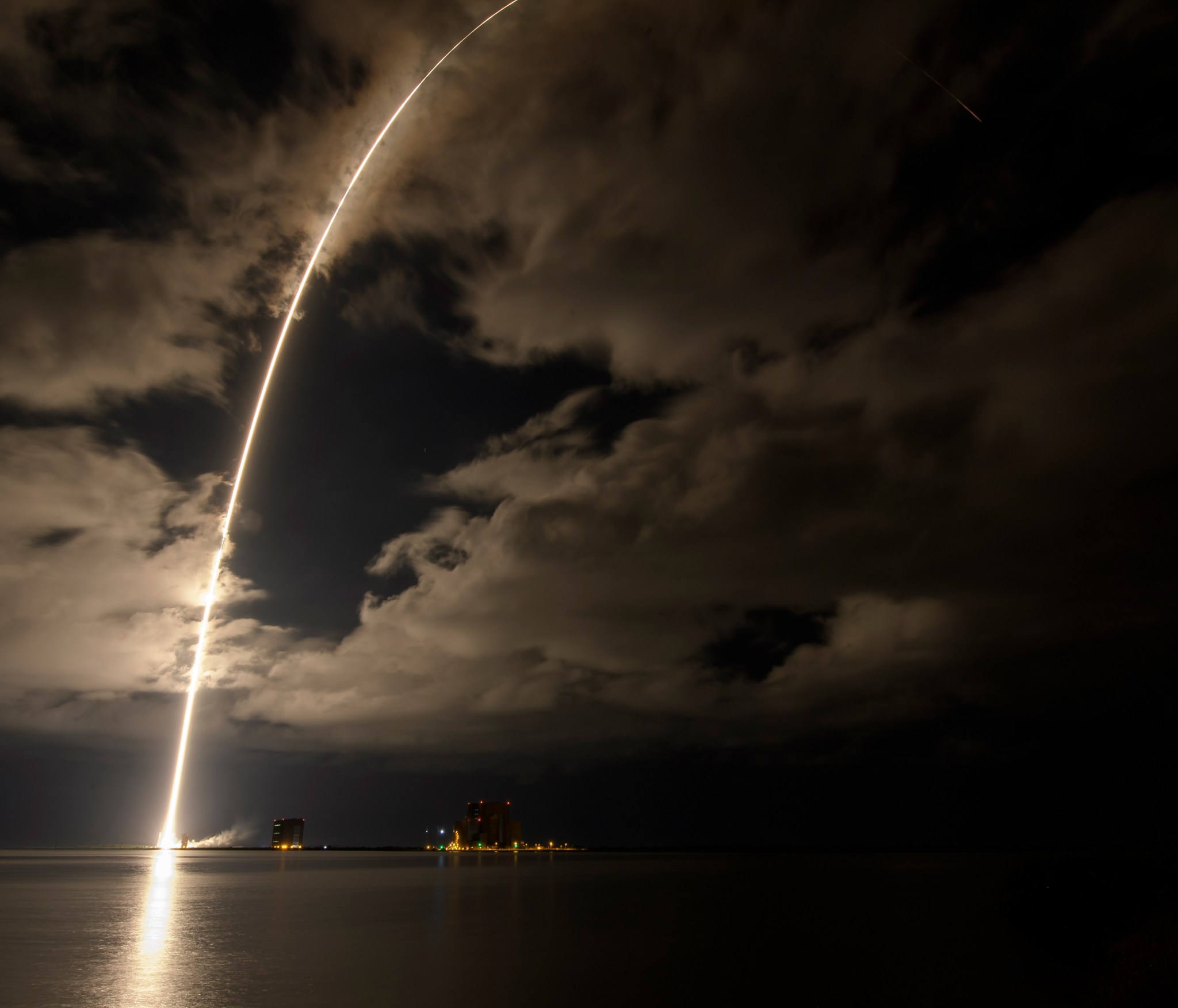
“Lucy embodies NASA’s enduring quest to push out into the cosmos for the sake of exploration and science, to better understand the universe and our place within it,” NASA Administrator Sen. Bill Nelson said. “I can’t wait to see what mysteries the mission uncovers!”
About an hour after launch, Lucy separated from the second stage of the Atlas V 401 rocket. Its two massive solar arrays, each nearly 24 feet wide, successfully unfurled about 30 minutes later and began charging the spacecraft’s batteries to power its subsystems.
“Today’s launch marks a genuine full-circle moment for me as Lucy was the first mission I approved in 2017, just a few months after joining NASA,” said Thomas Zurbuchen, associate administrator for the Science Mission Directorate at the agency’s Headquarters. “A true mission of discovery, Lucy is rich with opportunity to learn more about these mysterious Trojan asteroids and better understand the formation and evolution of the early solar system.”
Lucy sent its first signal to Earth from its own antenna to NASA’s Deep Space Network at 5:40 a.m. The spacecraft is now traveling at roughly 67,000 mph on a trajectory that will orbit the Sun and bring it back toward Earth in October 2022 for a gravity assist.
Named for the fossilized skeleton of one of humanity’s earliest known hominin ancestors, the Lucy mission will allow scientists to explore two swarms of Trojan asteroids that share an orbit around the Sun with Jupiter. Scientific evidence indicates that Trojan asteroids are remnants of the material that formed giant planets. Studying them can reveal previously unknown information about their formation and the solar system’s evolution in the same way the fossilized skeleton of Lucy revolutionized understanding of human evolution.
“We started working on the Lucy mission concept early in 2014, so this launch has been long in the making,” said Hal Levison, Lucy principal investigator, based out of the Boulder, Colorado, branch of Southwest Research Institute, which is headquartered in San Antonio. “It will still be several years before we get to the first Trojan asteroid, but these objects are worth the wait and all the effort because of their immense scientific value. They are like diamonds in the sky.”
Lucy is the 13th mission in NASA’s Discovery Program, which the agency’s Marshall Space Flight Center manages through its Planetary Missions Program Office.
“Lucy is now officially in the sky with diamonds after a flawless and spectacular pre-dawn launch,” said Sherry Jennings, Lucy mission manager at Marshall. “My heart was racing as the rocket disappeared momentarily in the clouds, but it soon broke through and lit up the sky in a blaze of glory. Lucy is on her way to unlocking the mysteries of the formation of our solar system. Godspeed, Lucy!”
Lucy’s Trojan destinations are trapped near Jupiter’s Lagrange points – gravitationally stable locations in space associated with a planet’s orbit where smaller masses can be trapped. One swarm of Trojans is ahead of the gas giant planet, and another is behind it. The asteroids in Jupiter’s Trojan swarms are as far away from Jupiter as they are from the Sun.
The spacecraft’s first Earth gravity assist in 2022 will accelerate and direct Lucy’s trajectory beyond the orbit of Mars. The spacecraft will then swing back toward Earth for another gravity assist in 2024, which will propel Lucy toward the Donaldjohanson asteroid – located within the solar system’s main asteroid belt – in 2025.
Lucy will then journey toward its first Trojan asteroid encounter in the swarm ahead of Jupiter for a 2027 arrival. After completing its first four targeted flybys, the spacecraft will travel back to Earth for a third gravity boost in 2031, which will catapult it to the trailing swarm of Trojans for a 2033 encounter.
Goddard Space Flight Center provides overall mission management, systems engineering, plus safety and mission assurance. Lockheed Martin Space in Littleton, Colorado, built the spacecraft.
Associate Administrator Cabana Tours Systems Integration Lab During Center Visit
Left photo: From left, Marshall engineers Deanna Whitehead and Dan Mitchell show NASA Associate Administrator Robert Cabana around the Systems Integration Lab during his visit to Marshall Space Flight Center on Oct. 13. The lab houses a variety of software and avionics configurations and integrated simulations for the Space Launch System. Engineers at the lab can create real-time simulations for the rocket’s extensive and incredibly intricate flight software and avionics hardware. Right photo: From left, Larry Leopard, Marshall Associate Director, Technical, joins Whitehead, Mitchell, and Cabana on the tour. While at Marshall, Cabana also visited Additive Manufacturing, the Environmental Control and Life Support System Laboratory and the Nuclear Thermal Propulsion Laboratory. (NASA/Emmett Given)
Ida Not First Storm Michoud Has Weathered in its 60-year History
By Matt Higgins
Michoud Assembly Facility was preparing to celebrate its 60th anniversary as a NASA facility Sept. 7, when Hurricane Ida struck the Louisiana coast as a Category 4 storm Aug. 29. Michoud has taken its licks from Mother Nature on multiple occasions since 1961, and each time the facility’s workforce rebounded to meet its mission mandate.
Hurricane Betsy: Michoud’s first major test came soon after it began work on the first stages of Saturn I and Saturn V rockets. Almost four years to the day that Michoud became a NASA facility, Hurricane Betsy struck the Louisiana coast Sept. 9, 1965, before making its way over the New Orleans area. Betsy was responsible for flooding over 22,000 homes in the region and became the first storm to cause over $1 billion in property damage, according to the Louisiana State Museum.
Cleanup and repairs to Michoud took weeks. Betsy collapsed the ceiling in the employee cafeteria, and the area around the S-IC final stage test facility looked like “an explosion fragmented the building,” the Marshall Star reported.
Despite the damage, Michoud reopened just days later on Sept. 13. Following successful checkout and weighing of the dynamic test stage, the first stage of the Saturn V, the S-1C, was placed on a barge at Michoud on Oct. 5 and shipped to NASA’s Marshall Space Flight Center on schedule.
Hurricane Katrina: Michoud continued rocket development for the Apollo program through the 1970s before building external tanks for the Space Shuttle Program through the program’s end in 2011. It served in an unexpected role when 80% of the city of New Orleans flooded after Hurricane Katrina hit Aug. 29, 2005.
During Katrina, 37 employees tasked with remaining on-site rode out the Category 3 storm, risking their lives to protect the facility and the flight hardware. Despite the conditions, water did not overtop Michoud’s levees and the facility’s pumps handled the rainfall. Michoud became an island and Federal Emergency Management Agency officials used it as a staging area for recovery operations.
Three months later, almost all of Michoud’s 2,000 workers returned, despite 600 of them having lost their homes. For their meritorious service, the ride out crew earned the NASA Exceptional Bravery medal from then-NASA Administrator Michael Griffin.
“It’s not about money or holding a job – it’s about dedication to the program,” Griffin said. “This is dedication money can’t buy.”
A recent surge of major storms: Hurricane Zeta hit Michoud in 2020, followed by Ida, but it was a tornado in 2017 that provided little warning before slamming the facility ferociously. On Feb. 7, 2017, the tornado touched down near Michoud, damaging 50% of the buildings – three of which had significant damage – and injuring five workers.
Less than a week later, crews restored power and utilities and Michoud reopened Feb. 13.
“The expertly trained Michoud workforce responded as they’ve done since 1961, with dedication and commitment to reopen the facility and continue with the NASA mission,” then-Michoud Deputy Director Robert Champion said.
After Ida passed, emergency and response crews who stayed on-site to monitor the storm assessed the damage. Power was restored about a week later, but some of the temporary repairs made after Zeta were undone by Ida. Adding insult to injury, the remnants of Tropical Storm Nicholas, which passed Sept. 15, flooded parts of the facility. Crews pumped out 65,000 gallons of water in Building 103 between the two storms
Despite the setbacks, the emergency response team protected vital flight hardware, keeping it safe from water damage. Michoud was back to its pre-Ida operation status the following week.
Michoud continues its work on the Space Launch System core stages as part of NASA’s Artemis missions – which will land the first woman and first person of color on the Moon. Prime contractor Boeing is building the core stage, which will be the largest rocket stage ever flown. It will store 733,000 gallons of super-cooled liquid hydrogen and liquid oxygen to fuel the four RS-25 engines that power the rocket. Lockheed Martin is manufacturing the Orion crew module, and its workers are also developing a launch abort system to protect the crew.
“This facility has weathered many storms the past 60 years. It continues to stand strong even though we have faced challenges,” Michoud Acting Director Lonnie Dutreix said. “This team has managed to build on the legacy of Apollo and shuttle and continues to build hardware for the Artemis missions.”
Higgins, a Manufacturing Technical Solutions employee, supports Michoud through Marshall’s Office of Strategic Analysis & Communications.
Marshall Hosts 32nd Small Business Alliance Meeting
NASA’s Marshall Space Flight Center welcomed more than 700 industry representatives from 40 states and nine countries to the 32nd Marshall Small Business Alliance meeting Oct. 14. The virtual event included presentations from NASA’s Office of Small Business Programs and updates on agency programs and business activities, including the reorganization of NASA’s human spaceflight operations, acquisition of services for the Human Landing System Program’s Lunar Exploration Transportation Services, and ongoing work to fly the Space Launch System – NASA’s new flagship to send explorers back to the Moon and pave the way to Mars. Speakers included Marshall Small Business Specialist David Brock, upper center; Todd Pospisil, upper right, deputy director of Marshall’s Office of Procurement; and Debbie Batson, lower left, events coordinator for Marshall’s Prime Contractor Supplier Council. Others included Glenn Delgado, associate administrator of NASA’s Office of Small Business Programs in Washington, Robert Champion, director of Marshall’s Office of Center Operations, and representatives of the Huntsville/Madison County Chamber of Commerce and the U.S. Space & Rocket Center. The meeting was sponsored by Marshall’s Office of Procurement and Small Business Office. Learn more here. (NASA)
Former Astronaut Andrew Allen to Deliver Virtual Talk on Safety, Operational Excellence
Former astronaut Andrew Allen, now CEO at Aerodyne Industries, will give a presentation via Webex at 11:30 a.m. Oct. 21, as part of the Mission Success is in Our Hands virtual lecture series. Aerodyne Industries, located in Cape Canaveral, Florida, is a service-disabled veteran-owned engineering and IT solutions company. Allen also is vice president and supports the senior vice president of advanced engineering, research, and operations. He represents Jacobs in industry partnerships focused on NASA and space explorations. He was previously vice president and general manager of Jacobs Space Operations Group at NASA’s Kennedy Space Center. Allen will share his experiences and perspectives on safety, operational excellence, and workforce performance. He is a three-time space flight veteran and space shuttle commander, with over 900 hours in space. The Mission Success is in Our Hands initiative is a campaign led by the Safety and Mission Assurance Directorate at NASA’s Marshall Space Flight Center and partner Jacobs Engineering that promotes and strengthens Marshall’s focus on mission, hardware, and crew safety. (Aerodyne Industries)



























